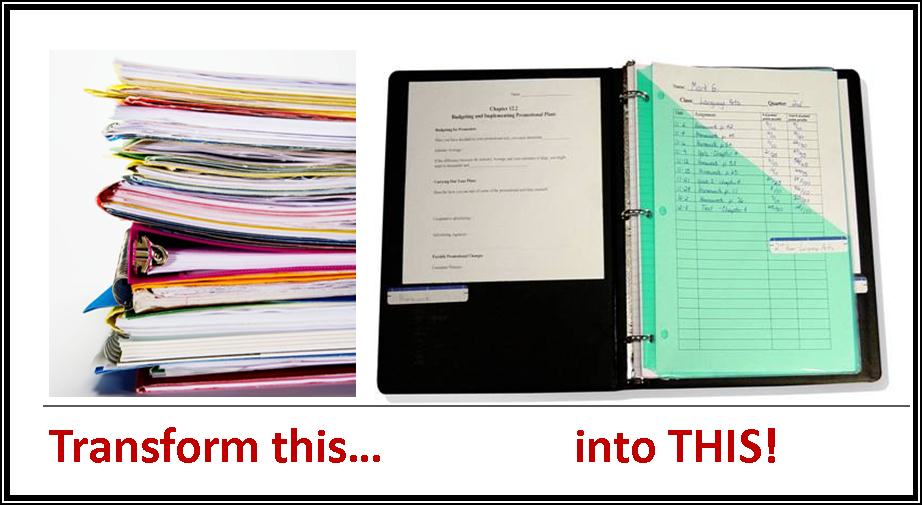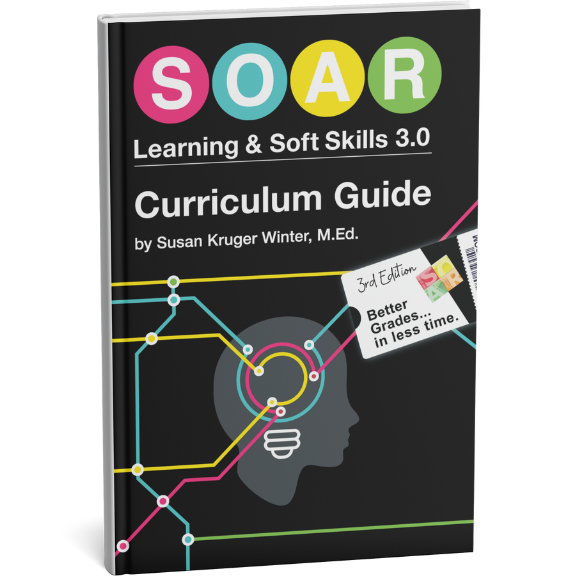Why Organization Is Such a Challenge for Students
Do any of these situations sound familiar…?
Rhonda’s teacher passed out homework to each student as they walked out of class this morning. Rhonda had a full stack of books in her arms and her bag was over her shoulder. Her teacher placed the paper on top of her books as she raced off to her next class. Rhonda didn’t notice the paper fly right out of her arms as she plowed through the crowded hallway.
When Ryan got his homework this afternoon, he folded and placed it neatly inside his notebook. At his locker two hours later, Ryan looked at his notebook and thought, “I don’t need this for homework,” and put it back in his locker. When he got home to do that worksheet, he couldn’t remember where he put it. He lost 45 minutes digging through his bag, searching inside all of his folders, books, and notebooks…and came up empty-handed.
Gunner was rushing to catch his bus at the end of the day. He quickly stopped at his locker and grabbed what he thought was his math notebook. When he got home, however, he realized that he actually grabbed his science notebook instead.
Colleen finished up all of her homework at home, quickly! “DONE!” she thought, as she excitedly jumped up and went off to watch TV. But, when she got to school the next morning, her homework was still sitting where she left it the night before.
Dan was just as eager to finish his homework so he could hit the “Done!” button in his brain. He even remembered to toss his homework in his bag. As he continued to clean up his work, he put a couple of textbooks back in his bag, too. The next morning, he shoved his lunch in his bag, as well, and flung the bag over his shoulder. He walked to the bus stop and through the halls of school, on his way to class. By the time he looks for his homework in class, he couldn’t find it! He didn’t know it, but it had been mashed to pulp under his lunch and books…and completely disappeared.
Why Is This Happening?
There are three main reasons students have trouble staying organized:
- They have too much “stuff.” Most students have 12 to 16 different folders and notebooks to manage through several transitions: from home, in the car/bus, to school, in the locker, back into the book bag, into class, back to the locker, and then home again. (Elementary students may only have a half dozen folders, but that’s still five more than they should have!)
- Everything looks alike. When those folders and notebooks are stacked in the locker or book bag, they all look the same!
- Any time students are managing papers, they are in a hurry. Whether they are rushing out of class at the end of an hour, rushing from their locker at the end of the day, or rushing to finish their homework at home, they are always in a hurry.
Let’s Relate This to Our Lives as Adults
Can you imagine having 12 to 16 different email accounts to maintain every day? What if you were expected to log into each account several times a day, respond to emails and retrieve old/sent emails at the snap of a finger? It would be overwhelming to transition between them quickly.
This is what students deal with every day, managing so many different school supplies. They have the added burden of managing these materials across several daily transitions.
Teachers have good intentions when they ask students to maintain a separate folder and notebook for their class; they think that separate supplies will make it easier for students to keep science papers organized in the science folder and math papers organized in the math folder.
However, this traditional system actually creates the problem! The sheer volume of folders and notebooks (not to mention textbooks and workbooks) complicate everything!
As a result, students haphazardly throw papers the first place they can. Later, they have no idea what they did with their papers. Papers can be anywhere…
How Can You Possibly Solve These Problems?
The first step in the organizing process is to eliminate the unnecessary items filling the book bag. This includes old papers, crusty lunches from two weeks ago, and anything else that is not strictly needed for school. Develop a routine for cleaning out the book bag as the first step of “homework time” every evening.
Next, eliminate folders and notebooks. Condense the mountain of folders and notebooks into ONE 1-inch or 1.5-inch binder. (Yes, it is possible to do this!) Replace two-pocket folders with poly binder pockets. Replace spiral notebooks with loose-leaf notebook paper, organized behind each folder. Now, students have only ONE tool for organization instead of 12 to 16.
The binder works best as part of a simple organizational system. This system is described thoroughly in the SOAR® Study Skills Curriculum.
The SOAR® Binder System has 72% fewer steps than the usual system for keeping papers organized. This makes students 72% likely to keep their assignments organized and turned in on time!
To learn more about the SOAR® curriculum, click here.
-Susan Kruger
EB 050917
Six Steps
Conquer the Chaos
Get Our Free Guide & Information on...
 How to Organize & Motivate Students for Success
How to Organize & Motivate Students for Success
"*" indicates required fields
Get Our FREE Curriculum Guide!
The SOAR® Curriculum
The most critical learning, organizing, and communication skills needed for school. Learn more here.
Who’s Using SOAR®?
SOAR® Guarantee
Click here to learn more.





